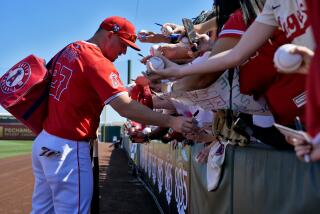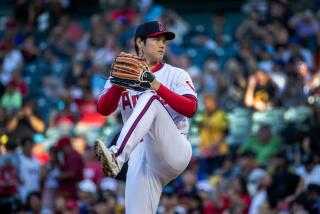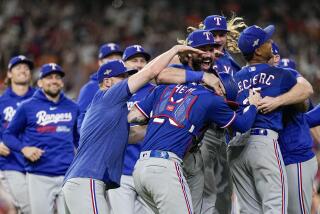Parting Shots : Jose Canseco Can’t Figure Out Why He Was Traded, but the A’s Had Their Reasons
PORT CHARLOTTE, Fla. — Jose Canseco explains that he has been divorced twice recently and “both should be good for me.”
He was divorced by his wife, Esther, over the winter after an August split with the Oakland Athletics, when he was traded to the Texas Rangers for Ruben Sierra, Jeff Russell and Bobby Witt.
Of that sudden and surprising separation from the A’s, Canseco still seems to harbor irreconcilable differences while insisting he is happy and healthy in his new environment and confident of his status as a premier power hitter.
“I don’t have anything to prove except that I can still be consistent, that I can still hit home runs, steal bases and play to the levels I always have when I’m not restricted injury-wise,” he said.
“There are some people who seem to think I’m washed up, going downhill, but it’s tough to be a premier player when you’re not healthy, and I wasn’t last year. Now, it’s different. This is the best I’ve ever felt.”
The bulging disk in Canseco’s lower back and a strained right shoulder diluted his power and bat speed in 1992 and limited his availability.
“I was down, and the A’s kicked me like a dog,” he said of the trade that he learned about when called back from the on-deck circle before a first-inning at-bat on Aug. 31.
Canseco said at the time that he wondered if the calender was wrong and this was an April Fool’s Joke. He is still wondering.
“I’m glad to be out of there, but I still can’t figure why I’m out,” he said in the Rangers’ clubhouse.
“I guess when your own fans start booing a guy who averaged 35 to 40 homers a year, it’s a sign you’ve worn out your welcome and should move on, but I still didn’t see it coming and still don’t understand it.
“How do you trade a guy who’s been with the organization for 10 years, who’s hit more home runs in the last seven years than anybody in baseball, who was the first player to hit 40 and steal 40 bases in the same season, who’s only 28 and has helped your club reach the World Series three times and has helped put them six games ahead (in the American League West when traded)?
“I’d understand if I was 35 or 36 and my skills were declining and my salary was exorbitant, but right now I’m a comparative bargain. When you look at the money, the production, the fan appeal, there’s not one thing that points to Oakland getting rid of me.”
That the A’s did, he said, was a blessing because they forced him to play hurt, continued to blame him for the 1990 World Series loss to the Cincinnati Reds, used and abused players through the pressure on winning and failed to make the same commitment to the players that they expect the players to make to the organization.
“There’s a lot of guys there who feel the same way I do, but they’re afraid to say anything,” said Canseco, whose closest friend with the A’s, shortstop Walt Weiss, was traded to the Florida Marlins immediately after the expansion draft.
Asked about Canseco’s comments, Weiss said: “I don’t want to say anything about the A’s, but I know Jose was hurting (physically) and I think it was time for him to move on, that it will prove to be the best thing for him.
“I know he’s determined to have a big season, and I think he will. He can be absolutely scary when he’s in that groove.”
Restricted to 97 games before the trade and 119 overall, Canseco hit .244 with 26 home runs and 87 runs batted in. The batting average was his lowest since 1986. The homer per at-bat ratio of 16.9, while fifth best in the league, was his worst since ’87.
It was the only season, other than 1989, when he suffered a broken hand, that Canseco failed to hit at least 31 home runs and drive in 100 runs.
The A’s, then and again this spring, have cited several reasons for the trade--publicly and privately.
--Russell and Witt added playoff depth to an injury-riddled pitching staff, and Sierra figured to pick up much of Canseco’s offensive slack.
--With 13 players eligible for free agency (Russell and Sierra made it 15), they were faced with reorganizing the payroll with an expected emphasis, at that point, on pitching.
--Although he hit 44 home runs and drove in 122 runs in 1991, the A’s were concerned about Canseco’s lingering back problems and penchant for off-the-field incidents that left the club fed up and convinced, as Manager Tony La Russa said recently, that Canseco’s priorities were “out of whack” and he was no longer committed to winning.
“You can tolerate big egos and what they say and do off the field if they give it their best on the field, like a Reggie Jackson did, but you never knew about Jose,” La Russa said. “We needed the pitching, but it would have been a much tougher deal to make if Canseco’s priority had been on winning instead of his own statistics.
“He believed that if he hit 30 home runs and drove in 100 runs, the rest of the team would complement it. He didn’t understand that it was the other way around--that he benefited from what the team did. I mean, I’m sure he has a tough time separating that truth from his own rationale.”
Said Canseco: “How could I not have a commitment to winning when the team on which I was the primary run producer won four division titles when I was there (the fourth was clinched in the month after he was traded)?
“When the A’s needed me, I was there,” Canseco added. “But it was a one-way commitment.
“I played hurt for them all year last year because they kept saying, ‘75% of Jose is better than nothing.’ I mean, you take the right side away from a (right-handed) power hitter and there’s no power, but I was made to play under those conditions. I was never given time to rest and heal. What they call healing is a shot in the arm and the order to go out and play.
“That’s not healing. That’s masking the pain. Who knows? Maybe it caused even more damage.
“There’s just so much tension, so much pressure, so much emphasis on winning, winning, winning with the A’s at no matter the cost or how they use people. And if they don’t win, they blame it on one individual as they did me after the 1990 World Series (in which he batted .083 and was criticized by La Russa for defensive lapses).
“That’s the most absurd, immature, self-righteous thing I’ve ever heard. One player doesn’t win or lose a World Series by himself, but instead of being classy about it and saying we lost as a team, they laid it on me. Talk about not protecting your players and not being committed to them.”
Esther and Jose Canseco have had their disagreements since, and even played bumper tag with automobiles at times, but Jose undoubtedly applauded when Esther called La Russa a “punk” for his criticism of her husband after that World Series.
Jose Canseco now refers to La Russa as an “iron-fisted manager and politician,” who knows how to stir up and play to the masses with his comments, some of which obviously hurt.
“I’d like to go into Oakland and sweep every game, but I’d like to do that everywhere,” Canseco said. “No matter the motivation, it’s all the same. You can’t get caught up in it. I like our team, and I know that if I stay healthy I’ll have a very good year. It gets frustrating when you can’t do the things you’ve always done just because you’re hurt.”
Rest removed the sting from his ailing shoulder, Canseco said, and he is controlling the lower-back problem with exercise. As a player traded with a multiyear contract, he had the right to demand a trade or become a free agent if the Rangers didn’t comply, but he let the deadline pass and bought a home in the Arlington, Tex., area instead.
Canseco is guaranteed $13.6 million over the final three years of his five-year contract--the A’s re-signed Sierra and Mark McGwire for five years at $28 million each--and Tom Grieve, Texas general manager, called it “comparatively reasonable” for a player of Canseco’s stature.
“We weren’t going to (be able to) sign Sierra, and it was unlikely we could sign Russell,” Grieve said. “It came down to Canseco for Witt, and we felt it worth the gamble.
“I have great respect for the A’s management and players, but the fact is that Canseco was a key reason they won consistently. He was a key player on some very good teams and, with the other players we’ve added, he gives us some immediate credibility.
“We had some concerns with his back and shoulder, but we also felt that he has always taken pride in his physical status and would come back 100% after a winter of rehabilitation.
“We had no concern with his priorities or history off the field. Much of that has been magnified because he’s Jose Canseco. He’s 28 now and maturing. With everything else he has to offer, we decided that we would judge him on what we saw of him as a Ranger. We haven’t been disappointed.”
Grieve said Canseco has displayed the patience of Nolan Ryan with autograph seekers, but has been quick to jump on the fundamental lapses of teammates. New Manager Kevin Kennedy visited Canseco in Miami during the winter and asked him to take on a leadership role.
“I take people at face value,” Kennedy said. “I don’t want a bunch of clones out there.”
Only Canseco arrives at the Rangers training complex in a red Lamborghini, often throws knuckleballs off a bullpen mound in the hope the Rangers will let him pitch, saunters through pregame workouts wearing sunglasses but no cap and takes batting practice left-handed.
Priorities?
“I like my players to be loose and having fun, but I want them to play with intensity,” Kennedy said. “That’s what we get with Jose.”
In addition, Canseco represents:
--A marketing tool when the Rangers move into their new stadium next season.
--A liaison to the Latin contingent of Rafael Palmeiro (Canseco’s friend since boyhood, who has said that Canseco’s arrival provided both with a new life), Juan Gonzalez, Ivan Rodriguez and Julio Franco.
--A potent bat in the middle of one of the league’s most potent lineups, a hitter who has produced a home run every 14.4 at-bats in Arlington Stadium compared to 16.2 at-bats in the spacious Oakland Coliseum.
The Rangers, Grieve said, are out of excuses and capable of winning the division. The signing of shortstop Manny Lee and second baseman Bill Ripken solidified a porous defense. The addition of Tom Henke, Charlie Leibrandt and Craig Lefferts provided veteran depth and reliability to the pitching staff.
Only time will determine which way the Rangers and Canseco are headed. Can he rejoin the elite, or is he on a downward slide that he can’t reverse, physically or mentally?
“No matter what I do, I’ll never be able to fill the shoes some people want to put on me,” Canseco said. “I mean, players of my caliber are always caught between a rock and hard place. I wish people could accept the fact that I do my best, but that doesn’t seem to be enough.”
The A’s questioned whether he was giving his best, questioned his commitment and priorities. Catcher Terry Steinbach joined the chorus, saying Canseco was “selfish” and not a “team player.”
They didn’t question his talent.
“I will never be surprised by what he does or accomplishes,” La Russa said. “His ability is unlimited. He can carry a club for months if he is focused.”
Canseco shook his head, saying it has never been a question of focus, only health. Perceptions vary in every divorce.
More to Read
Go beyond the scoreboard
Get the latest on L.A.'s teams in the daily Sports Report newsletter.
You may occasionally receive promotional content from the Los Angeles Times.









